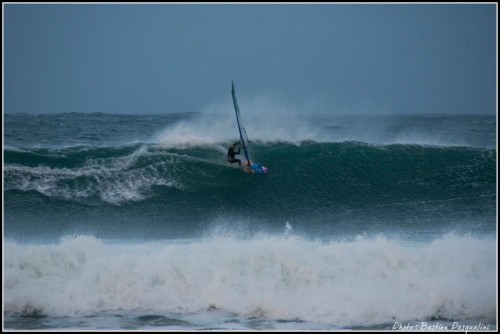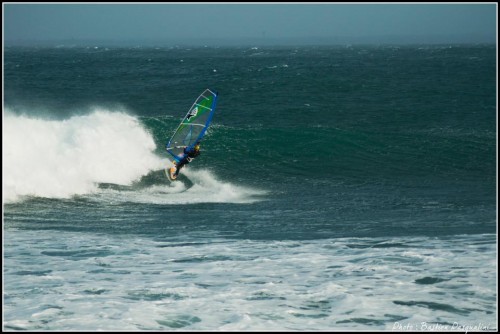Ireland part 4
by Graham
I’m back on Maui and the conditions are super fun, but here is a flashback to last month’s Irish adventure.
4.
It makes sense to go in wintertime from warm Hawaii, home of the best waves in the world, to cold Ireland in search of waves. Right?…wait… Am I insane? “Never leave wind to find wind,” that’s the maxim windsurfers are so fond of saying at the beach. Yet, it’s not a rule we often follow. Our sport is migratory. In fact, to be a windsurfer is to be a nomad.
Of course there are the famous pilgrimages in our sport to the various Meccas. The Canary Islands for Europeans. The Gorge for American windsurfers. And Maui for everyone. But even the guy that never leaves his local lake travels when he sails from one side to the other and back again and again. “That’s not travel!” I hear someone shout, “he’s going in circles”. But ah! this circular nature is—in fact—definitional of travel. Travel is just as much about the going as it is the returning home with new eyes.
But this is not completely true for us ocean sailors. For us, ocean travel is two-faced because our home is the sea. Going from the Pacific of Maui to the North Atlantic of Ireland is not travel for me; I am simply seeing a different angle to the beauty of my mistress, the sea. And this is important because if you don’t know all her forms, you cannot begin to understand her or see her as she is. It is for this same reason that people who don’t sail generally don’t see whitecaps on the waves.
All this nonsensical talk of travel was what I told myself over and over as I had the most difficult session of my life. The water was cold, the air was cold, the current was strong, the rocks were slippery and big, I’d never sailed in booties before, my board was a floater I’d never tried, and I’m not used to port tack. I could barely get high enough up wind against the current to catch waves. I was the only windsurfer sailing that day though, so at least it wasn’t crowded. Hahahah. But Ireland never gets crowded.
[pause] Actually, it is strange that there are no crowds. Ireland has some of the best surfing and windsurfing in the world. While waves all over the world get more and more crowded every year (mainly by Brazilian and Australian surfers… how do they do it?), the Irish coast remains quite virgin.
My friend and companion Brendan has his own theory: the Irish people turn their backs on the sea. Once heard, this revelation seems obvious (as the most clever statements tend to do). The Irish culture centers itself around agriculture—cows, farming, and sheep—not fishing, despite being an island (and a pretty small one at that!). The houses aim their windows landward, leaving the sea-views vacant. Unlike most countries, the coastal towns are less busy than the completely landlocked ones. Brendan asked the caretaker of our cottage about his observation and the man (a kind farmer named Donal) agreed. Donal has lived in the same area for his whole life and near there is a pier protruding out into the sea. In all his years (over 50 of them), he has only been on the pier twice. The Irish turn their backs on the sea.
Why? Why does the Island look inward and back at itself? Well, Brendan says, “People are the same everywhere, but here the sea is different.” Here in Ireland the sea is violent. The same waves and wind that I traveled around the world to ride are too extreme for coexistence between the locals and the sea.
In Ireland, I hoped to meet a new personality of the ocean. And as I worked like hell to get upwind and to the waves’s peak to catch another ride, I laughed at my life: going through all the trouble of traveling with truckloads of gear to sail in the cold. And despite all that, I was skunked. Yeah I had a few days on the water, but I did not get the 40 foot swells and 30 knot wind for which I hoped. And then I realized that living for the sea—as we windsurfers do—is about existing in desire. I’m reminded of a Camus essay that I don’t want to look up because I’m afraid it’s not as good as what I remember. Basically one of the premises is that it is better to exist in desire than hope for satisfaction. A life of loving the sea is a life of nothing but building desire and a tension that builds with every session, brims with ecstasy, and sits on the verge of climax. This is how to love the sea.



.man, right know, i feel i wanna drink the water, but not from the pipe..:-)),
jump in to the sea..
Maaan, You make me wanna go there so much. I’m from Poland in central Europe and the idea of sailing ocean waves on totaly uncrowded spot strangely makes me feel so cosy and mind relaxing…
Nevermind the cold I’m used to it as usually half of my season in my country is in 10C water.
I wanna surf sooooo bad now…
cool post. http://www.oiemail.net